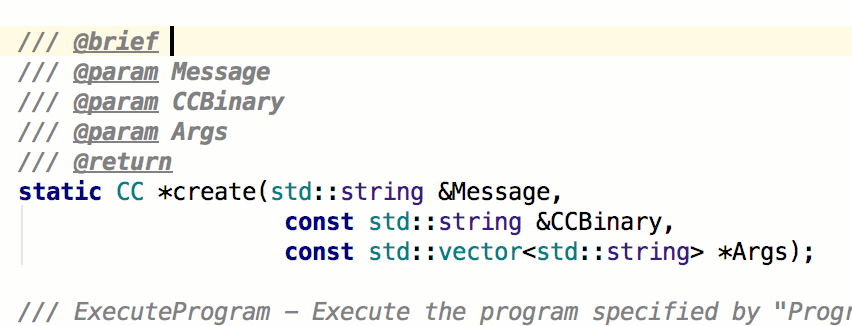
- #Doxygen list full#
- #Doxygen list verification#
- #Doxygen list code#
- #Doxygen list free#
Use to add supplemental information to a type description. The tag should be used to describe a type or a type member. / This property always returns a value < 1. This encoding is shown in the following example.
If you want angle brackets to appear in the text of a documentation comment, use the HTML encoding of, which is < and > respectively. Tags for generic types and methods - These tags are used only on generic types and methodsĭocumentation comments cannot be applied to a namespace. Generate links and references - These tags generate links to other documentation. Reuse documentation text - These tags provide tools that make it easier to reuse XML comments. Format documentation output - These tags provide formatting directions for tools that generate documentation. *: The value of this element is displayed in IntelliSense in Visual Studio. Tags used for members - These tags are used when documenting methods and properties. : The value of this element is displayed in IntelliSense in Visual Studio. General Tags used for multiple elements - These tags are the minimum set for any API. The compiler also validates, which is deprecated HTML. In addition to the tags listed here, the compiler and Visual Studio validate the, ,, , and tags. Visual Studio provides IntelliSense for the tags verified by the compiler and all tags followed by ** in the following list. The compiler verifies the syntax of the elements followed by a single * in the following list. This article describes the recommended tags organized by their use. Finally, some of the tags are used to format text in your documentation. Some of the recommended tags can be used on any language element. The compiler will copy these to the output file. #Doxygen list free#
Developers are free to create their own set of tags. 
#Doxygen list full#
To get full information about a type or member, use the documentation file together with reflection on the actual type or member. The XML file does not provide full information about the type and members (for example, it does not contain any type information). The tag is used by IntelliSense inside Visual Studio to display additional information about a type or member.The compiler respects any using statements when it looks for a type described in the cref attribute.
#Doxygen list verification#
If the verification fails, the compiler issues a warning.
#Doxygen list code#
The compiler verifies that this code element exists.
The cref attribute can be attached to any tag to reference a code element. If used, the compiler verifies that the parameter exists and that all parameters are described in the documentation. The tag is used to describe parameters. Some of the recommended tags have special meanings:. The documentation file will contain a comment that says that an error was encountered. If the XML isn't well formed, the compiler generates a warning. The documentation must be well-formed XML. 
The processing of these comments has some restrictions: When you create a new project, the templates put some starter /// lines in for you.
Partial classes are fully supported, and documentation information will be concatenated into a single entry for each type. Documentation text should be written using complete sentences ending with full stops. At a bare minimum, types and their members should have a tag because its content is needed for IntelliSense. However, it exposes the inner (potentially confidential) workings of your library. Private members can also be documented using XML comments. For the sake of consistency, all publicly visible types and their public members should be documented. In all cases, you should adhere to these recommendations: While you can put any tags into your documentation comments, this article describes the recommended tags for the most common language constructs. What follows are some recommendations, general use case scenarios, and things that you should know when using XML documentation tags in your C# code. While you can use any valid XML in your comments (including any valid HTML element), documenting code is recommended for many reasons. The C# compiler copies these elements into the output XML file. One consequence of this feature is that you can add any valid XML in your documentation comments. C# documentation comments use XML elements to define the structure of the output documentation.






 0 kommentar(er)
0 kommentar(er)
